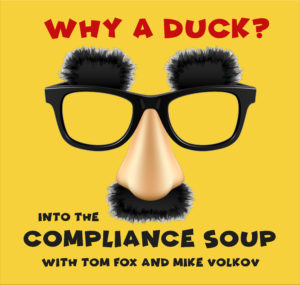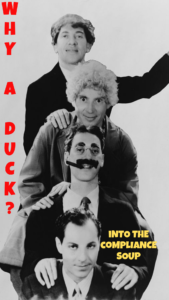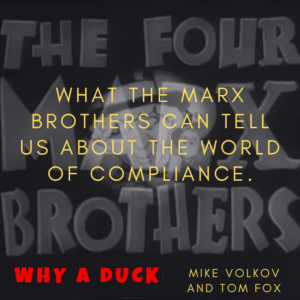New Podcast: Tom Fox and Michael Volkov — Why a Duck? Into the Compliance Soup with Tom Fox and Michael Volkov

I am proud to announce the launch of a new podcast with my friend and colleague, Tom Fox.
In recognition of our mutual appreciation for the Marx Brothers and compliance, Tom and I decided to create a new podcast — Why a Duck? Into the Compliance Soup with Tom Fox and Michael Volkov.
The first two episodes are available Here.

In the first episode, Tom and I introduce the new podcast and discuss our mutual admiration for the Marx Brothers.
The title Why a Duck comes from a line in the famous 1929 Marx Brothers film Coconuts: “ Why a duck? Why no chicken? Why no horse?”
Duck Soup is Tom’s favorite Marx Brothers movie. The film depicts a series of farcical efforts where rivals try to overthrow Rufus T. Firefly. It is political chaos at its finest. Tom especially enjoys the mirror scene.
Mike’s favorite Marx Brothers movie is Day at the Races. Hugo Hackenbush is a vet posing at a doctor at Standish Sanatorium to take care of his wealthy patient Emily Upjohn. The sanatorium is in financial trouble. The film shows his hilarious schemes to get a horse to win a race so that he can pay off the sanatorium debts. Mike shares a funny story of how the Marx brothers cornered Irving Thalberg into a meeting.
In the second episode, Tom and I discuss the new compliance guidance and relate them to strategies to build an effective compliance program.
Mike’s favorite Marx Brothers movie Day at the Races is a fitting analogy for the race to effective compliance. Mike shares his favorite lines from the movie after which the discussion focuses on 3 Best Practices Compliance programs from the Criminal Division of the Department of Justice and OFAC.
Tom points out that each guidance document has a different focus depending on who released it. The Antitrust Guidance for example, is focused on criminal antitrust behavior: that is, the intention to defraud the market based on market fixing, cartel behavior or other intentional acts by more than one group or person. Each one of the documents gives greater insight to anti-corruption practitioners to incorporate into their compliance program.

There are elements that are common to all three documents. Mike says this emphasizes the importance of operationalizing your program to cut through the silos that exist in compliance. Compliance now has a reason to bring together all these elements into one comprehensive training program.
The Criminal Division of the Department of Justice asks for continuous monitoring of the compliance program. We need to take the data and loop it back into the compliance program to continually improve. Antitrust monitoring takes a statistical look at contract data over long periods of time to discover indications of cartel or price-fixing behavior.
Anti-corruption monitoring shows the need for overall transaction monitoring from a compliance perspective so that red flags or anomalies are detected early on.
Once you have a database of contracts you can now have effective business analysis. You can analyze discounts given to customers over time and compare and contrast profit margins of contracts by geographical area or business unit. This is going to put the Compliance at the table for business discussions going forward. Compliance now becomes part of the business plan.















